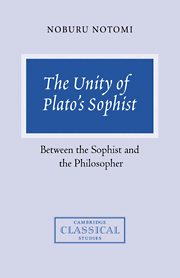Book contents
- Frontmatter
- Dedication
- Contents
- Preface
- Notes and abbreviations
- Division of the Sophist
- 1 How to read the Sophist
- 2 The sophist and the philosopher
- 3 How the sophist appears
- 4 Analysis of the structure of appearance
- 5 Appearance and image
- 6 The sophistic counter-attack on philosophy
- 7 The philosophic defence against sophistry
- 8 The final definition of the sophist
- Bibliography
- Index locorum
- General index
1 - How to read the Sophist
Published online by Cambridge University Press: 05 June 2014
- Frontmatter
- Dedication
- Contents
- Preface
- Notes and abbreviations
- Division of the Sophist
- 1 How to read the Sophist
- 2 The sophist and the philosopher
- 3 How the sophist appears
- 4 Analysis of the structure of appearance
- 5 Appearance and image
- 6 The sophistic counter-attack on philosophy
- 7 The philosophic defence against sophistry
- 8 The final definition of the sophist
- Bibliography
- Index locorum
- General index
Summary
The many appearances of the Sophist
What is the Sophist, usually deemed one of the greatest philosophical works of Plato? What philosophical problem does Plato propose and investigate in this dialogue?
The Sophist has many faces, each of which has attracted philosophers for two millennia. The issues discussed in the dialogue are all known to be so problematic and so important in the history of philosophy that philosophers have hardly ever asked what problem the Sophist really confronts, or what these issues are to be examined for. They have taken the ‘problems’ for granted. The variety of the philosophical issues it raises, however, makes us fail to see the dialogue as a whole. Each philosopher has taken up only a piece of the dialogue, so that the faces of the Sophist remain fragmentary; the Sophist has not shown us the whole figure nor its essence.
Let us begin our examination by considering how we can approach the dialogue, through a survey of the many faces it has shown its past readers.
With its traditional subtitle ‘On what is’ (peri tou ontos, de ente), the dialogue was treated, from antiquity to the Renaissance, primarily as a masterpiece of Plato's ontological thinking.
First, Plato tackles in Sophist 236d–242b the problem of ‘what is not’ (to mē on), which has proved one of the most important issues in Greek philosophy since Parmenides originally raised the issue. Parmenides, in his verse, strongly opposed ‘what is not is’, and his successors had to prove the possibility of the being of what is not, in order to secure change and plurality in our world.
- Type
- Chapter
- Information
- The Unity of Plato's SophistBetween the Sophist and the Philosopher, pp. 1 - 42Publisher: Cambridge University PressPrint publication year: 1999



